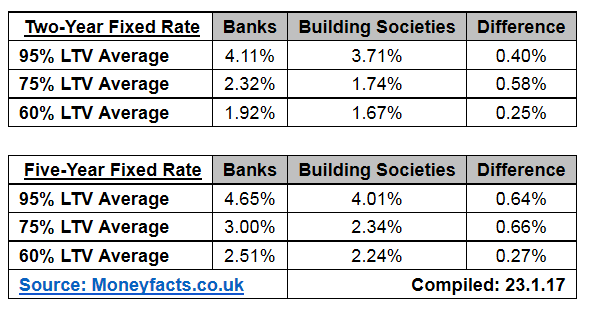Building Societies are Winning the Mortgage Interest Rate War
Interest-Rates / Mortgages Jan 23, 2017 - 02:31 PM GMTBy: MoneyFacts
With competition still fierce in the mortgage market and many banks claiming to launch the lowest products ever on their records, many borrowers could assume that the mortgage rates from these providers will be significantly lower than those offered elsewhere. However, Moneyfacts.co.uk research shows that building societies are the winners when it comes to the mortgage rate war.

Charlotte Nelson, Finance Expert at Moneyfacts.co.uk, said:
“Building societies are making their mark on the mortgage market, leaving the banks behind in their wake. It seems that despite mortgage rates falling to record lows, banks are still failing to compete on cost. In fact, the average two-year fixed rate at 75% loan-to-value (LTV) provided by building societies is a massive 0.58% lower than that offered by banks.
“The domination of building societies is clear to see when you cast your eye over the Best Buy tables, with five out of the six two-year fixed rate mortgage Best Buys being offered by mutuals. More importantly, the lowest deals aren’t just reserved for those with larger deposits; building societies are hitting it out of the park for those with smaller deposits too. For example, borrowers opting for the average five-year fixed rate 95% LTV would find themselves £71.98* a month worse off if they were to choose a mortgage from a bank instead of a building society.
“Putting customers first is what mutuals strive for, which is clearly reflected by the fact that borrowers are being offered much lower rates compared to their banking rivals. Building societies also have a lot more flexibility when it comes to their approach to underwriting, allowing them to opt for a more personal approach.
“The gap between the banks and building societies suggests that now is the time for borrowers to look away from the big banks and consider something closer to home for a more competitive and cost-effective deal.”
*Repayment based on a £200,000 loan over 25 years.
www.moneyfacts.co.uk - The Money Search Engine
Moneyfacts.co.uk is the UK's leading independent provider of personal finance information. For the last 20 years, Moneyfacts' information has been the key driver behind many personal finance decisions, from the Treasury to the high street.
© 2005-2022 http://www.MarketOracle.co.uk - The Market Oracle is a FREE Daily Financial Markets Analysis & Forecasting online publication.



